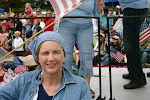By Lyn Jensen
"You can't really respect and honor [America's
Vietnam] veterans without acknowledging they were leaders of the antiwar
movement." -- Tom Hayden
Ron Kovic remains perhaps
the most famous face of the movement for veterans’ rights. In the early
seventies he galvanized the peace movement, both as an anti-Vietnam activist
and as the author of Born on the Fourth
of July. That book, a searing account of one paralyzed veteran’s shattered
illusions turning to activism, has become an American classic. It was even
turned into an Oscar-nominated film in 1989, starring Tom Cruise as Kovic.
Today veterans of Iraq
and Afghanistan are complaining about the level of care they receive, and that makes
Kovic’s experience freshly relevant. In particular what fueled Kovic’s
transformation were the conditions he and many other disabled veterans
encountered at the Long Beach Veterans Administration. Believing that the level
of care amounted to patient abuse, Kovic organized more than a dozen of his
fellow patients. Unable to create change within the system, they resorted to
what might now be called “occupy tactics.”
On Feb. 12, 1974, Kovic
and fourteen other disabled veterans (along with some supporters including two
women) arrived for a meeting at then-senator Alan Cranston’s office at the
Westwood Federal Building. Finding the senator absent, they refused to leave,
or even eat, until the head of the VA (at the time, Donald Johnson) met with
them personally and heard their grievances. The occupation of Cranston’s office
ended on March 2, 1974, after then-president Richard Nixon sent Johnson to meet
with them.
Now Kovic has written a
book, Hurricane Street, about the
protest and its aftermath. Like its author, the book was born on the fourth of
July, published by Akashic Books on that date this year.
Hurricane describes how Kovic
originally planned the protest to be the first action of a new American
Veterans Movement, which he organized from his residence on Hurricane Street in
Marina Del Rey. The next step was to be a veterans’ march on Washington on July
4, 1974, envisioned to rival or surpass both the 1964 King March and the
protests that vets staged in Washington during the Depression.
The planned march on
Washington ended in failure when other veterans’ groups refused to participate.
Days later, Kovic was kicked out of his own organization (he suspects outside
influences) and the movement disbanded.
At the age of 70 and still living in
the South Bay, Kovic remains a patient of the Long Beach VA, where the reforms
he demanded in 1974 have resulted in much higher standards of patient care.



0 Comments:
Post a Comment
Subscribe to Post Comments [Atom]
<< Home